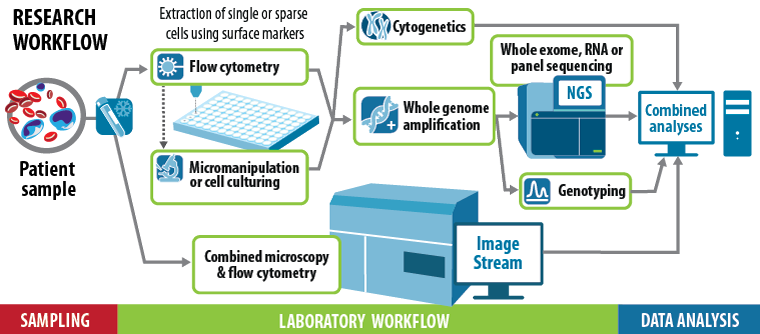Heterogeneity of malignant stem cells and clonal evolution in myeloid malignancies

The research group led by professor Peter Hokland addresses translational aspects of leukemogenesis primarily in myeloid malignancies. For the past decade, the concept of minimal residual disease (MRD) has been a major focus, and we have been performing comprehensive research aimed at showing a more profound understanding of the depth of MRD in both acute myeloid leukemia (AML) and chronic myeloid leukemia (CML). Recently, MD PhD Peter Niekerk showed that utilizing a combination of fluorescence activated cell sorting (FACS) and fluorescence in situ hybridization (FISH) analyses, MRD can be assessed at stem cell level in CML patients in deep molecular remission. In AML, MD PhD Anne Stidsholt Roug has identified the C-type lectin domain family 12 member A (CLEC12A) as a valid MRD marker. Currently, PhD student Laura Laine Herborg is investigating whether CLEC12A may also be a surrogate marker revealing underlying molecular aberrations in AML. In an ongoing project supported by the Danish Cancer Society, MD PhD Hans Beier Ommen and MSc PhD-student Anita Tranberg Simonsen are investigating clonal evolution and MRD in AML and CML during treatment and follow-up. In addition, this study includes an evaluation of the quality of life for patients followed on an extended outpatient basis.
Increasing evidence from international research shows that many hematological malignancies are maintained by a very small subset of cells with stem cell features; leukemic stem cells (LSC). Such LCSs are believed to be enriched in MRD and are regarded as responsible for relapses in AML. In our group, MSc PhD Anni Aggerholm has demonstrated the persistence of DNMT3A mutations in adult patients with AML in long-term remission, indicating the existence even of pre-leukemic stem cells. Thus, in natural continuation of our former and ongoing research, we are now also aiming at developing new tools for identifying putative LSCs. The methodologies are based on immunophenotyping, cell sorting and functional analyses of cell subfractions in long-term cultures and the analyses also include the ability to perform mutational characterization of malignant clones down to a very low number of cells by next generation sequencing - an approach which until recently has been out of reach. Thus, in collaboration with MsC Marcus Celik Hansen, our research group is elucidating the heterogeneity in a smaller proportion of sorted LSC-fractions from AML and MDS patients by performing gene expression analyses on the single cell level.
Moreover, we have introduced aldehyde dehydrogenase (ALDH) activity as a putative LSC marker in our experimental work to refine the characterization and isolation of LSCs. MD PhD Marie Bill has recently shown the relevance of CLEC12A as a stem cell marker in MDS and are currently evaluating the combination of ALDH activity and expressed CLEC12A surface protein, as an assembled marker of cancer stem cells in both AML and MDS. In order to obtain a more profound understanding of CLEC12A as a stem cell marker, we are also delineating the expression of CLEC12A in healthy peripheral blood and bone marrow, including immature myeloid progenitor cells.
The addition of increased spatial resolution to the methodologies, such as implementation of imaging flow cytometry, will lead to a more thorough characterization of the myloid malignancies. In our group MSc PhD Carina Agerbo Rosenberg has initiated a project that uses this technology in investigation of bone marrow dysplasia in myelodysplastic syndrome (MDS).